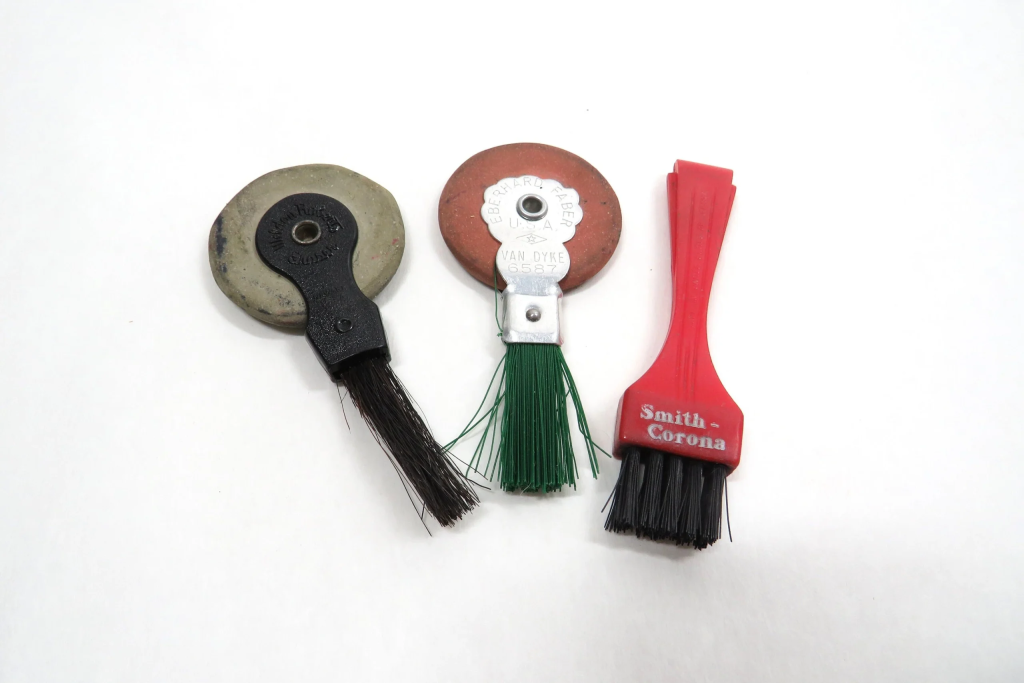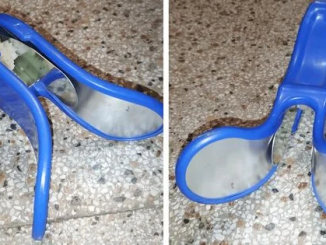What Are Typewriter Eraser Brushes?
The circular objects in the image are typewriter erasers, which came with a small brush attached to them. The erasers themselves were made from soft materials like rubber, often infused with fine abrasives.
This combination was designed to remove ink or typewriter ribbon marks from paper, which was the
primary method of correcting mistakes on a typed document before the advent of white-out or digital editing.

The small brush on the tool was used to gently whisk away the eraser debris left on the paper after erasing a letter or a word. In an age when typewriters ruled the business and literary worlds, these tools were essential to maintaining neat and professional-looking work.
A Snapshot in Time: When Eraser Brushes Were Essential
In the early to mid-20th century, typewriter eraser brushes were as common as correction fluid or digital backspace keys are today. Every typist had one on their desk because, despite their best efforts, mistakes in typing were inevitable. These tools allowed for correcting those mistakes without the need to retype an entire
page.
Back then, carbon paper was often used for making copies, so one mistake could mean fixing multiple sheets of paper. Eraser brushes were gentle enough not to tear the delicate paper yet effective at removing the erroneous marks.
The Decline of the Typewriter Era
With the rise of word processors and eventually personal computers, typewriters
quickly became obsolete. The need for such specialized erasers faded as digital
text allowed for instantaneous editing. Today, these erasers are rare relics from a
time when typing was both an art and a skill.
For those who remember using these eraser brushes, seeing one today is a nostalgic reminder of how much the world of writing and editing has evolved. The phrase “times have changed” has never been truer, especially when comparing the
challenges of fixing a typewritten document to the ease of modern technology’s undo button.
A Niche Collectible
Today, typewriter eraser brushes are considered collectibles. Vintage enthusiasts and lovers of retro office supplies value them for their simplicity and effectiveness. Though they might look out of place in a world dominated by digital devices, they serve as a testament to the ingenuity of past generations and the unique tools
that once supported everyday tasks.
Conclusion: From Essential to Obsolete
For those who’ve never used a typewriter, the tools in the image may seem mysterious, even obsolete. But for older generations, they bring back memories of the rhythmic clacking of typewriter keys, the smell of ink ribbons, and the ever- present eraser brush sitting nearby. Times have certainly changed, and as with many innovations, what was once essential now rests quietly in history’s archives
Angelina Jolie’s eldest daughter: From a tomboy with braces to a new generation of expensive beauty

he first biological daughter of Hollywood power couple Brad Pitt and Angelina Jolie, Shiloh Nouvel Jolie-Pitt, 16, has captivated the world with her incredible transformation at just 16 years old. Shiloh is becoming well-known in the entertainment business, having gone from being a tomboy with braces to a mesmerizing teenager.
Shiloh is a well-known celebrity offspring who has attracted a lot of media attention. Her remarkable likeness to her well-known mother, Angelina Jolie, has won praise from many. She effortlessly transcends her tomboy persona, embodying a flawless synthesis of her parents’ most prominent traits with her appealing round eyes, big lips, and thin physique.
The red carpet appearances Shiloh made with her mother only helped to increase her notoriety. There is a lot of conjecture surrounding her possible modeling career, as prominent model management companies have shown a strong interest in her. Her promising future in the fashion industry portends a future filled with recognition and financial success.

As Shiloh celebrates turning 16, her unmatched beauty and charm portend a bright future in show business.



Leave a Reply